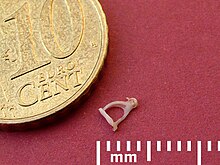Stirrups (anatomy)
The stapes (Latin: stapes ) is the third of the auditory ossicles in the middle ear of mammals . The stirrup is the smallest bone in the human body and was discovered as an ossicle by the anatomist Giovanni Filippo Ingrassias in the 16th century. It is on average 3.3 mm high, the footplate 3 mm long and 1.4 mm wide. It has a mass of 3 to 4 mg. The stapes gets its name because of its shape and creates a connection between the anvil, which is articulated to it, and the cochlea in the inner ear .
phylogenesis
In amphibians , reptiles and birds , the bone is better known as columella , it is derived from the hyomandibulars of the fish. In the bony fish (Osteichthyes), the os quadratum and os articulare form the primary jaw joint. The hyomandibular bone, on the other hand, connects the quadratum bone with the bones of the skull. Also in the reptiles the os quadratum and os articulare form a primary temporomandibular joint, but here the os quadratum is directly connected to the roof of the skull. In reptiles, the hyomandibular bone became the columella and thus an ossicle.
anatomy
The footplate of the stapes ( base stapedis , area about 3.2 mm²) touches the oval window of the cochlea and transfers the vibrations to the fluid inside the cochlea . Two legs ( crura stapedis ) extend from the footplate and meet in the neck. The latter goes over into the head, which is articulated to the anvil . The stapes emerge in the embryo from the upper part of the second branchial arch , the so-called hyomandibular (Reichert's cartilage). The unique in the animal kingdom form the stapes in mammals with two legs comes because the stirrups in the embryo to be later forming stirrup artery ( artery stapedial developed).
A muscle leading to the stapes ( Musculus stapedius ) can influence the mobility of the ossicular chain through tension. When the ear is exposed to high sound pressures, the muscle tenses reflexively and stiffens the ossicular chain. A protective function for the inner ear is ascribed to this process. The stapes muscle is the smallest muscle in the human striated muscles .
The stapedius reflex can be measured with the help of tympanometry and, among other things, says something about the tightness of the eardrum, the mobility of the ossicular chain and the state of nerve connections in the brain stem as well as the auditory and facial nerves .
task
In the middle ear, the hammer, anvil and stapes transmit the vibrations of the eardrum to the oval window. Their task is the low-loss transmission of the sound. The vibrations of the membrane in the oval window generated by the stapes shift the perilymph .
See also
Individual evidence
- ↑ Barbara I. Tshisuaka: Ingrassias, Giovanno Filippo. In: Werner E. Gerabek , Bernhard D. Haage, Gundolf Keil , Wolfgang Wegner (eds.): Enzyklopädie Medizingeschichte. De Gruyter, Berlin / New York 2005, ISBN 3-11-015714-4 , p. 673.
- ↑ Barry J. Anson, James A. Donaldson: Surgical Anatomy of the Temporal Bone . Saunders, Philadelphia 1981, ISBN 0-7216-1292-X .
- ^ A b Stanley A. Gelfand: Essentials of Audiology . Thieme, New York and Stuttgart 1997, ISBN 3-13-103631-1 , pp. 46 .
- ↑ Graphic on the development of the temporomandibular joints and their derivatives ( Memento from February 25, 2014 in the Internet Archive )
- ↑ Jan Langmann: Medical Embryology. Normal human development and its malformations. Thieme, Stuttgart / New York 1980, ISBN 3-13-446606-6 , p. 265
- ↑ Silbernagl, Stefan, Despopoulos, Agamemnon: Pocket Atlas of Physiology, Thieme Verlag, Stuttgart, 2001 p. 364.


